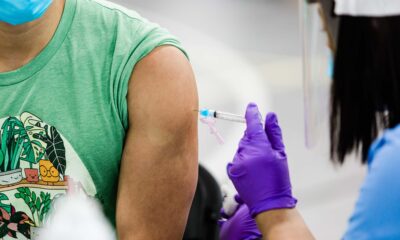NEWS
U.S. Anesthesia Partners Is Solving The Shortage Of Anesthesia Clinicians
Published
2 months agoon

Dr. M. Peterson
Professional medical associations in the U.S. have been sounding the alarm about clinician shortages nationwide, across all specialties, but one provider is already taking steps to ensure patient access to anesthesia for procedures ranging from colonoscopies to child birth to complex cardiac surgery and more. Out of approximately 100,000 full-time anesthesia clinician positions, there are over 14,400 openings according to the GasWork jobsite as of May 2024. This shortage stresses clinicians and administrators, increases costs, and sometimes leads to delayed or canceled procedures.
The good news is that anesthesia quality and safety remain at record highs. The challenge is how to provide access at all desired points of service.
U.S. Anesthesia Partners (USAP), a leading single-specialty anesthesia practice, has found success employing innovative strategies to bridge the gap between demand and supply in the recruitment and staffing of Certified Anesthesiologist Assistants (CAA), Certified Registered Nurse Anesthetists (CRNA), and Anesthesiologists.
“Job openings for these roles have surged by an astonishing 150% in the last several years with an annual growth rate averaging 17%. However, the supply of candidates has failed to keep pace,” said Neal Grabarkewitz, Senior Vice President – Head of Clinical Talent Acquisition at USAP.
The work begins with Recruitment:
USAP has invested in the anesthesia profession from the beginning of a clinician’s professional pipeline throughout their careers. USAP has more than 30 in-house recruiters and a network of affiliations, allowing it to identify and attract top talent while staying ahead of the staffing shortage. Since 2022, USAP’s physician and CRNA headcounts have increased 22 and 21%, respectively. In 2023, USAP was able to hire 872 clinicians.
Retaining and Nurturing Talent:
USAP takes additional steps to retain and nurture talent through their physician-owned, clinician-led structure. Empowering clinicians to foster a supportive environment for professional growth generates a sense of belonging within the organization. Both physicians and CRNAs are decision makers within USAP’s key committees, furthering collaboration, and diverse decision-making within the organization, while employee engagement surveys and market compensation surveys ensure fair rewards for professionals at all levels.
Investing in the Future of Anesthesia:
“USAP is training more care teams than any other entity in the U.S. In fact, in 2023, USAP trained 355 clinicians,” Grabarkewitz said.
USAP is developing a pipeline of skilled practitioners through meticulously crafted residency programs:
– Orlando, Florida (planning to accept applications by the end of this year)
Their efforts extend through affiliations with over 32 programs training future CRNAs and 8 Student Anesthesia Assistant (SAA) programs to cultivate a network of emerging talent, provide hands-on experience and offer leadership development seminars that occur each year during USAP’s Resident Leadership and Future CRNA Leadership conferences it hosts, where tenured anesthesiologists and CRNAs within USAP spend time teaching students and residents about medical and professional aspects their future job will require.
“By empowering practices with robust recruitment strategies, a culture of collaboration, and a dedication to excellence, USAP continues to make a positive impact on Anesthesia nationwide,” Grabarkewitz said.
TMX contributed to this article.
Related Topics:

More From Lifestylogy
-


25 Fruits That Last The Longest After Purchase
-


FDA Approves Updated Covid-19 Booster Shots From Pfizer and Moderna
-


20 Things People Mindlessly Spend Their Money On That Might…
-


20+ Things Online Shoppers Regret Buying Within Days
-


Beware: These 12 Popular Foods Could Wreck Your Cholesterol Levels
-


LiveGood’s Membership Model Keeps High-Quality Vitamins And Supplements Affordable